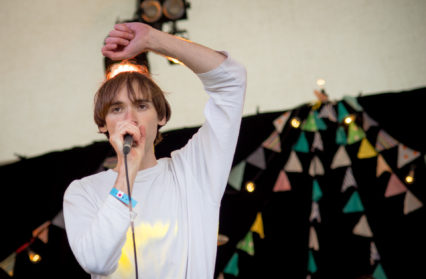It’s been five years since Meilyr Jones released 2013, his critically acclaimed solo debut. A baroque, classic-pop opus, Caragh Medlicott takes a look back at what made Jones’ album so unique in both inspiration and execution.
For the writers of the Romantic period, all roads really did lead to Rome. The moneyed and the lovelorn flocked to the eternal city’s sun-soaked cobbles to delight in its rich repertoire of history and art. This pilgrimage, and the Romantics who made it, would – two centuries on – inspire one Meilyr Jones to do the same.
Jones’ own Italian escapade came shortly after the split of his first band, Racehorses. With idle time, and a small amount of cash, Jones skipped across the continent for a six-week Roman holiday. As inspiring as the trip turned out to be, he didn’t set out with any music-making ambition in mind. Instead, the city presented an opportunity to experience a wash of culture – a chance to enjoy things both old and new, grand and urban. It was this experience which became the basis for Jones’ solo debut, 2013 (named for the year of its origin); an ostentatious, coruscating record which is, in many ways, still peerless in the sheltered predictability of the indie-sphere.
2013 is not only bold, it is oxymoronic – somehow discordant and harmonious at the same time – knitting together seemingly unrelated sonic scraps and making them a cohesive part of a panoramic whole. Its sound is baroque, orchestra-led, mingling the operatic with the everyday. Here’s a 30-piece orchestra, here’s a birdsong; here’s a heavenly choir, here’s a busker’s accordion. The texture of Jones’ field recordings, dispersed throughout the album, capture real snippets of his stint in Rome. It is these samplings which make 2013 not just a musical palimpsest for a lapsed holiday, but a tangible vehicle for lived memories – like crumpled train tickets and dried flowers pasted into the pages of a travel journal.
It’s clear that Jones is no studio-drone, his passions animate him and keep him pushing forward. He is a renowned frontman, as inventive as he is electric. With an album full of dizzying compositions, 2013 is almost impossible to replicate live, and Jones – in the many years he has been performing it – has been known to continually vary things up with different musicians hand-picked for their own unique take on the record. During Sŵn Festival 2016, I saw Jones perform twice in one day. Once for a short, intimate gig in Cardiff’s Spillers Records and later with a headline set played to a beer-drenched crowd at the Tramshed. His ability to occupy both spaces was profound, and notably, intuitive. Unlike so many young artists today, Jones’ live persona doesn’t appear heavily affected, or based in mimicry – it speaks to the power of not only charisma but the genuine love felt for the music being performed; to the vitality of its continual invention and reinvention.

But then, this is hardly surprising given the record’s attitude. The first track from 2013 – ‘How To Recognise a Work of Art’ – is not only a brass-beat pop-bop, it is plied with questions of authenticity. It’s a fun song, and lyrically obscure, the overall message – if anything – seems to be that we should all lighten up a bit. It’s a sentiment echoed with more severity on the following track, ‘Don Juan’, where Jones sings: ‘There’s a band on the radio singing politely’. Simple yet cutting, it’s an observation which may well be aimed less at a particular artist and more at the musical bubble of Radio 6, where, at times, even the eclectic can begin to feel predictable. Set to a Medieval-esque cacophony of harpsichord and piano, it certainly sounds esoteric. Still, criticism is far from the overriding theme of 2013 – its outlook can only be defined by its duplicity. On ‘Love’, Jones takes a true Romantic turn – ‘God is a bee / God is a tree’ – he sings, finding divinity in the pastoral. While ‘Olivia’, replete with operatic choir, brandishes the unlikely unrequited love story of a ‘Broke white girl/ Singing Sweet Home Alabama’ and an ‘Old man on an old piano’.
Hector Berlioz – the 19th-century composer whose biography Jones was reading prior to initiating 2013 – actually bears certain similarities to Jones himself. Berlioz was an avid Lord Byron fan, and he also made the move to Rome to complete a musical scholarship. Perhaps the most poignant similarity – or difference, depending on your perspective – is Berlioz’s idée fixe (fixed idea). A term which, in Berlioz’s case, refers to the Shakespearean actress he fell in love with; a yearning which inspired his famed Symphonie Fantastique. For Jones, it seems, his first and foremost obsession is dynamism itself. In an interview from 2016, Jones commented: “I think the moment you start looking back you’re in danger, because you start to see yourself with outside eyes.” Agitation is Jones’ well of creativity – staleness, meanwhile, is its antithesis.
Still, with everything from Bowie nods to DH Lawrence references, it’s fair to say that 2013 is intertextual in its scope. In the wrong context, Jones’ passion for Byron and Keats, for Berlioz and German philosophy, might strike some as elitist. Yet – perhaps because of his lack of cynicism – these touchstones feel genuine, refreshing in their lack of self-consciousness. The inclusion of, say, a reading of Torquato Tasso’s Io son la primavera, belies genuine reverence, rather than pretension. He has no interest in obscuring his influences, and perhaps that gives stock to the old adage, (commonly attributed to Piccaso), that, “good artists copy; great artists steal”.
If Romanticism was a departure from the Enlightenment period which came before, Meilyr Jones’ 2013 – with its expansiveness, its drama, and its strangeness – is a rejection of modern indie lore. Five years on from its release, and we’re still waiting for a follow-up (not that Jones hasn’t been busy, turning his hand to soundtrack composition for Shakesperian productions). With a view from 2021, what is perhaps most remarkable about 2013 is that, even half a decade later, it still feels as fresh, eclectic and bursting with life as the bouquet of flowers adorning its cover.
(Image credits: Paul Hudson via Flickr)
Caragh Medlicott is a Wales Arts Review senior editor.
_______________________________________________________________________
Recommended for you:



 Enjoyed this article? Support our writers directly by buying them a coffee and clicking this link.
Enjoyed this article? Support our writers directly by buying them a coffee and clicking this link.








